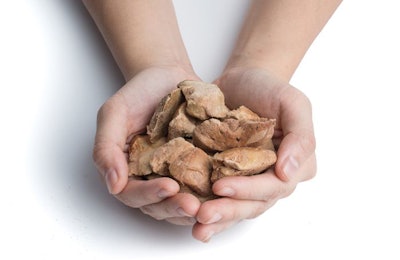
Freeze-dried ingredients appeared in several new pet food products introduced at SuperZoo 2021. Demand for freeze-dried meats, fruits and vegetables continues to grow, as pet food makers look for ways to differentiate their products while preserving ingredients’ nutrients. As freeze-dried ingredients grow in popularity, one equipment manufacturer noticed two categories for their use in pet food.
Freeze-dried pet food ingredient demand growth
Freeze-dried pet food has grown 50% year-over-year for Muenster Pet Foods, Mitch Felderhoff, president of Muenster Pet Foods said. Muenster also makes traditional kibble, andsees the freeze-dried products as a natural evolution for dog, cat and other animal diets.
“The pet food industry has done a great job advancing kibble, but it's really gone almost about as far as it can go,” Felderhoff said. “The next step is adding stuff to it, like a freeze-dried inclusion piece, to really add more value for the customer and increasing nutrition for the pet.”
Mueller produces a range of freeze-dried items including muscle meat treats, bone broth, powdered ingredients and complete pet foods, along with treats made with a mix of freeze-dried and other ingredients. Private equity firm Kainos Capital acquired Muenster Milling, including its pet food division, in August.
Freeze-dried pet food ingredient types
Two main categories of freeze-dried products have driven growth, Blair Kibblewhite, sales and marketing manager for equipment manufacturer Cuddon Freeze Dry, wrote in an email.
- Raw - These uses high quality ingredients that are freeze dried with minimal handling to produce a premium product.
- Sustainable - The other type of freeze-dried ingredient uses materials that might otherwise have been wasted, she said, or sold for lower prices. Instead, the misfit materials are freeze-dried as upcycled pet food ingredients.
“This idea has been around for a while but as we become more environmentally aware, the extent and cost of wastage is being better understood,” Kibblewhite said. “Products are being developed that take materials previously flushed down a drain or used as fertilizer on fields, and turning them into ingredients in their own right.”
Freeze-dried ingredients help pet food companies meet consumer demands for raw or minimally processed ingredients. Freeze-drying can maintain aspects of the ingredients lost when heated.
“When we're freeze drying it, we're pulling the moisture out without applying extreme heat,” Felderhoff said. “We're doing it under a vacuum pressure, so we have less denaturing of proteins. We have more integrity in the vitamin and mineral composition that we put into the product. Typically in freeze-dried, what you put in the product is what you get out of that product as well.”
As pet owners continue to focus on health and nutrition aspects of their animals’ foods, freeze-dried ingredients may help pet food companies provide shelf-stable, minimally processed options. A literature review in the journal Foods concluded that freeze-drying of plant-based ingredients allows greater nutrient retention than other methods. However, freeze-drying also used four to ten times more energy than conventional hot air dehydration, which may make it more expensive and resource intensive.

















